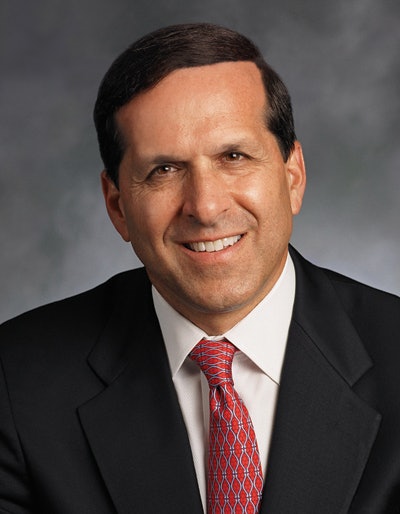
It's human nature to focus on what's in front of us right now. It's also human nature to believe that whatever is happening currently will either continue or get better. For dentistry, this means that if practices are performing at a level that is satisfactory, we don't spend time focusing on how to protect our future. Unfortunately, we now live in a time with an uncertain economy and unexpected changes.
Dental practices, like all businesses, should spend some time focusing on protecting their futures. This can seem like a waste of time, because it may not be necessary if the practice simply continues to perform well or get even better automatically. But what if things change?
Three foundations to protect your future
 Dr. Roger P. Levin.
Dr. Roger P. Levin.Protecting your future is no different than buying insurance. When you really think about it, you don't want to ever see the benefit from your homeowner's insurance.
You pay the money every year and hope that you're throwing it away. The same may be true in business, but the difference is that if you invest in protecting your future and nothing uncertain or negative ever happens, then you are only better off.
What are some of the uncertainties that could happen? The obvious ones include increased competition, lower insurance reimbursements, the loss of one or more key team members, or an illness with the doctor. Then there are the uncertainties that are discussed in business conferences, such as recession, inflation, government regulation, etc. One current example is that the U.S. Congress recently considered adding dental benefits in a much bigger way to Medicare, and that would have specific ramifications for many practices.
Regardless of the potential uncertainties, protection should be part of every dental practice's strategic plan. As the CEO of a dental management consulting firm that has participated in strategic planning with hundreds of offices, I often find that the one missing link in a practice's strategic plan is what it will do to protect its future. This is uncovered during an exercise referred to as a SWOT (strengths, weaknesses, opportunities, and threats) analysis.
A SWOT analysis is quite common in the business world. While I have observed that many dentists get extremely excited about practice strengths, weaknesses, and opportunities, their energy typically drops regarding threats, because they haven't happened yet, and no one is quite sure whether they will happen. But threats are real, and in dentistry, if you prepare for a threat that doesn't happen, the practice still benefits.
So, let's look at three foundational factors that you should be working on right now, whether you need them today or not as protection for the future.
1. Design documented, proven, step-by-step systems
Practice success will be directly proportional to the quality of your systems. Your systems may be good or at least functional right now. You may be hitting the production, profit, and income numbers that you need to support the practice, your lifestyle, and retirement savings; however, your systems may not be sufficient in getting through an adverse situation, and then you will be racing to try to replace them. It takes at least 12 months to properly update systems, so it is far better to be proactive rather than reactive.
Answer the following questions:
- Are your systems documented so that any team member can access them to train and learn?
- Are the systems designed like a step-by-step instruction manual to make it easy for current and new team members to train rapidly?
- Do you review parts of systems in regular meetings so that they are always front and center?
- Have the systems been proven in other offices so that you're not wasting time on trial and error?
- Do the systems include the proper scripting that helps people to implement them quickly and effectively?
Systems are the foundation of any practice and will determine the short-term and long-term success. The system you have today may be good, but not good enough for an uncertain tomorrow.
2. Create a powerful brand statement
Do you have a distinctive, thought-out brand statement that can be used repeatedly to communicate to patients and the community about what your practice stands for? Brand statements should be shared regularly with every patient, in every new patient phone call, and within a 30-day communication plan that we recommend to all practices as a regular way to reach patients and update them on the practice.
Go online and look up the brand statements of companies ranging from Amazon to the Dollar Store. In fact, the Dollar Store brand statement literally is the name of the store itself. Determine your brand statement, use it often, and use it in all marketing and communication activities.
3. Build higher value now
Build value in every single patient interaction, every single time, no matter what. Another way to say it is that whether you touch a patient in person, through email, virtually, or by phone, you must always create value with value statements. Talk about your focus on customer service, excellence in care, new technologies added to the office, or any other value-building statement that can help patients and potential patients understand the benefits of your practice.
You may not think you need this and simply assume that your patients know what you stand for; however, consider why any of your patients leave your practice. (The average annual patient loss is around 15%!) If you are near that figure, or worse, you can assume that some patients are not just leaving because they moved or changed insurance companies. Value-building statements can help to avert some of these losses.
Summary
Protecting the future is just as important as attaining success in the present. The difference is that we don't think about protecting the future against uncertainty or situations that haven't yet occurred and may never occur. If you review the three recommendations in this article, you will see that even if the negative situation never happens, the practice will only be better off in the long run.
Dr. Roger P. Levin is CEO of Levin Group, a leading practice management and marketing consulting firm. To contact him or to join the 40,000 dental professionals who receive his Practice Production Tip of the Day, visit LevinGroup.com or email [email protected].
The comments and observations expressed herein do not necessarily reflect the opinions of DrBicuspid.com, nor should they be construed as an endorsement or admonishment of any particular idea, vendor, or organization.



















